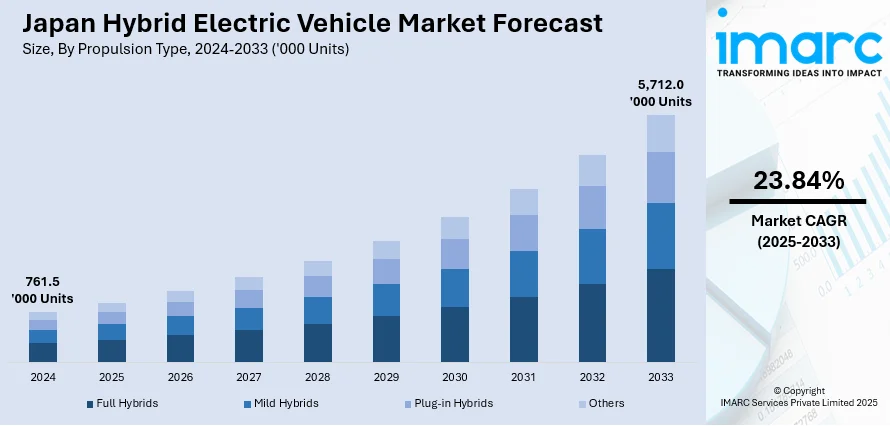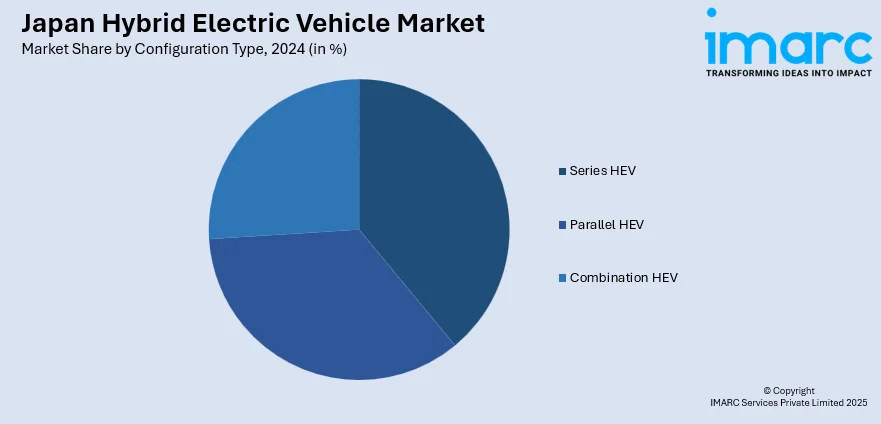
Japan Hybrid Electric Vehicle Market Size, Share, Trends and Forecast by Propulsion Type, Configuration Type, Vehicle Type, Power Source, and Region, 2025-2033
Japan Hybrid Electric Vehicle Market Overview:
The Japan hybrid electric vehicle market size reached 761.5 Thousand Units in 2024. Looking forward, IMARC Group expects the market to reach 5,712.0 Thousand Units by 2033, exhibiting a growth rate (CAGR) of 23.84% during 2025-2033. The ongoing advancements in full hybrids, mild hybrids, and plug-in hybrids, increasing adoption of series, parallel, and combination HEVs, expanding demand across passenger cars, commercial vehicles, and two-wheelers, and rising investments in stored electricity and onboard electric generators are significantly expanding the Japan hybrid electric vehicle market share.
|
Report Attribute
|
Key Statistics
|
|---|---|
|
Base Year
|
2024 |
|
Forecast Years
|
2025-2033
|
|
Historical Years
|
2019-2024
|
| Market Size in 2024 | 761.5 Thousand Units |
| Market Forecast in 2033 | 5,712.0 Thousand Units |
| Market Growth Rate 2025-2033 | 23.84% |
Japan Hybrid Electric Vehicle Market Trends:
Rising Consumer Demand for Fuel Efficiency and Sustainability
The Japan hybrid electric vehicle market growth is driven by the increasing consumer preference for fuel-efficient and eco-friendly transportation solutions. For instance, Fujitsu Limited and Sustainable Shared Transport Inc. (SST), a division of Yamato Holdings Co., Ltd., announced the opening of a cooperative delivery and transportation system for shippers and logistics companies in Japan on January 27, 2025. Through this platform, SST, which was founded on May 21, 2024, seeks to create a sustainable supply chain by leveraging information sharing and standardized pallet shipping. In order to help create a sustainable logistics network, Fujitsu will invest 50% in SST and use the service as a shipper. With rising fuel prices and growing awareness of carbon emissions, more individuals are opting for hybrid vehicles as a cost-effective and environmentally responsible choice. Government policies, including tax incentives and subsidies, have further encouraged HEV adoption, making them more affordable for a larger population. Japanese automakers, such as Toyota and Honda, are leading the charge by continuously innovating hybrid technology, offering improved battery efficiency and regenerative braking systems. The demand for HEVs is also driven by urban consumers seeking sustainable mobility options amid strict emission regulations. Moreover, advancements in hybrid powertrains and lightweight materials are enhancing vehicle performance while reducing operational costs. As Japan aims for carbon neutrality by 2050, the HEV market is expected to play a crucial role in achieving sustainable transportation goals.

Technological Advancements and Expansion of Charging Infrastructure
The rapid evolution of hybrid electric vehicle technology is propelling Japan’s HEV market, with major automakers focusing on enhanced battery performance and energy efficiency. The integration of solid-state batteries and improved hybrid drivetrains is increasing vehicle range while reducing reliance on fossil fuels. Japan’s investment in expanding charging infrastructure, including fast-charging stations in urban centers, is further promoting hybrid vehicle adoption. Automakers are also introducing plug-in hybrid electric vehicles (PHEVs) that offer greater flexibility for consumers transitioning from traditional combustion engines to full electric mobility. Additionally, developments in smart vehicle connectivity, such as AI-driven energy management systems, are enhancing overall driving efficiency, which is positively impacting the Japan hybrid electric market outlook. With Japan’s commitment to reducing greenhouse gas emissions, government initiatives supporting research and development in hybrid technology are accelerating the market expansion. For instance, the government of Japan declared on February 18, 2025, that it will cut greenhouse gas emissions by 60% from 2013 levels by fiscal year 2035, with a further goal of 73% by fiscal year 2040. As part of its revised climate plan, Japan hopes to achieve carbon neutrality by 2050.
Japan Hybrid Electric Vehicle Market Segmentation:
IMARC Group provides an analysis of the key trends in each segment of the market, along with forecasts at the country level for 2025-2033. Our report has categorized the market based on propulsion type, configuration type, vehicle type, and power source.
Propulsion Type Insights:
- Full Hybrids
- Mild Hybrids
- Plug-in Hybrids
- Others
The report has provided a detailed breakup and analysis of the market based on the propulsion type. This includes full hybrids, mild hybrids, plug-in hybrids, and others.
Configuration Type Insights:

- Series HEV
- Parallel HEV
- Combination HEV
A detailed breakup and analysis of the market based on the configuration type have also been provided in the report. This includes series HEV, parallel HEV, and combination HEV.
Vehicle Type Insights:
- Passenger Cars
- Commercial Vehicles
- Two-Wheelers
- Others
The report has provided a detailed breakup and analysis of the market based on the vehicle type. This includes passenger cars, commercial vehicles, two-wheelers, and others.
Power Source Insights:
- Stored Electricity
- On Board Electric Generator
A detailed breakup and analysis of the market based on the power source have also been provided in the report. This includes stored electricity and on board electric generator.
Regional Insights:
- Kanto Region
- Kansai/Kinki Region
- Central/Chubu Region
- Kyushu-Okinawa Region
- Tohoku Region
- Chugoku Region
- Hokkaido Region
- Shikoku Region
The report has also provided a comprehensive analysis of all the major regional markets, which include Kanto Region, Kansai/Kinki Region, Central/Chubu Region, Kyushu-Okinawa Region, Tohoku Region, Chugoku Region, Hokkaido Region, and Shikoku Region.
Competitive Landscape:
The market research report has also provided a comprehensive analysis of the competitive landscape. Competitive analysis such as market structure, key player positioning, top winning strategies, competitive dashboard, and company evaluation quadrant has been covered in the report. Also, detailed profiles of all major companies have been provided.
Japan Hybrid Electric Vehicle Market News:
- On December 18, 2024, Honda Motor Co., Ltd. unveiled its next-generation e:HEV hybrid system. Its newly designed 1.5-liter and 2.0-liter direct-injection Atkinson cycle engines are intended to increase fuel efficiency by more than 10% over earlier models. To maximize economy and performance, the upgraded e:HEV system smoothly transitions between EV Drive Mode, Hybrid Drive Mode, and Engine Drive Mode. In line with its objective of becoming carbon neutral by 2050, Honda has set an annual sales target of 1.3 million hybrid-electric vehicles worldwide by 2030.
- On December 20, 2024, Toyota Motor Corporation declared that its brand-new Alphard and Vellfire Plug-in Hybrid Electric Vehicle (PHEV) models would be introduced in Japan on January 31, 2025. Under WLTC mode, these minivans, which were Japan's first PHEV models in this class, had a driving range of roughly 73 kilometers when in battery electric vehicle (BEV) mode. Toyota also improved the Hybrid Electric Vehicle (HEV) and gasoline versions of both models, which will be on sale on January 7, 2025.
Japan Hybrid Electric Vehicle Market Report Coverage:
| Report Features | Details |
|---|---|
| Base Year of the Analysis | 2024 |
| Historical Period | 2019-2024 |
| Forecast Period | 2025-2033 |
| Units | Thousand Units |
| Scope of the Report |
Exploration of Historical Trends and Market Outlook, Industry Catalysts and Challenges, Segment-Wise Historical and Future Market Assessment:
|
| Propulsion Types Covered | Full Hybrids, Mild Hybrids, Plug-In Hybrids, Others |
| Configuration Types Covered | Series HEV, Parallel HEV, Combination HEV |
| Vehicle Types Covered | Passenger Cars, Commercial Vehicles, Two-Wheelers, Others |
| Power Sources Covered | Stored Electricity, On Board Electric Generator |
| Regions Covered | Kanto Region, Kansai/Kinki Region, Central/Chubu Region, Kyushu-Okinawa Region, Tohoku Region, Chugoku Region, Hokkaido Region, Shikoku Region |
| Customization Scope | 10% Free Customization |
| Post-Sale Analyst Support | 10-12 Weeks |
| Delivery Format | PDF and Excel through Email (We can also provide the editable version of the report in PPT/Word format on special request) |
Key Questions Answered in This Report:
- How has the Japan hybrid electric vehicle market performed so far and how will it perform in the coming years?
- What is the breakup of the Japan hybrid electric vehicle market on the basis of propulsion type?
- What is the breakup of the Japan hybrid electric vehicle market on the basis of configuration typw?
- What is the breakup of the Japan hybrid electric vehicle market on the basis of vehicle type?
- What is the breakup of the Japan hybrid electric vehicle market on the basis of power source?
- What is the breakup of the Japan hybrid electric vehicle market on the basis of region?
- What are the various stages in the value chain of the Japan hybrid electric vehicle market?
- What are the key driving factors and challenges in the Japan hybrid electric vehicle market?
- What is the structure of the Japan hybrid electric vehicle market and who are the key players?
- What is the degree of competition in the Japan hybrid electric vehicle market?
Key Benefits for Stakeholders:
- IMARC’s industry report offers a comprehensive quantitative analysis of various market segments, historical and current market trends, market forecasts, and dynamics of the Japan hybrid electric vehicle market from 2019-2033.
- The research report provides the latest information on the market drivers, challenges, and opportunities in the Japan hybrid electric vehicle market.
- Porter's five forces analysis assist stakeholders in assessing the impact of new entrants, competitive rivalry, supplier power, buyer power, and the threat of substitution. It helps stakeholders to analyze the level of competition within the Japan hybrid electric vehicle industry and its attractiveness.
- Competitive landscape allows stakeholders to understand their competitive environment and provides an insight into the current positions of key players in the market.
Need more help?
- Speak to our experienced analysts for insights on the current market scenarios.
- Include additional segments and countries to customize the report as per your requirement.
- Gain an unparalleled competitive advantage in your domain by understanding how to utilize the report and positively impacting your operations and revenue.
- For further assistance, please connect with our analysts.
 Request Customization
Request Customization
 Speak to an Analyst
Speak to an Analyst
 Request Brochure
Request Brochure
 Inquire Before Buying
Inquire Before Buying




.webp)




.webp)












